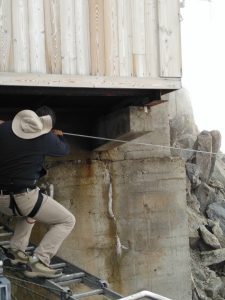For those just joining the fun, this is another installment from the Epic Vacation files. (For a different set of notes on Chamonix plus bits of England and Italy, with more kids of more ages, check out Bearing Blog September 2017. Do you want to know what is cool? Being in Chamonix and getting tips from Erin Arlinghaus on fun things to do there. We totally took some of her advice. Read her blog before you travel.) Today’s topic is spurred by a combination of waking up to snow this morning in Kentucky and seeing a friend’s zipline photos.
July in Chamonix is where people from not-snow-places can experience snow. Down in the valley it was sunny and warm and the grass was green. So we used our lift passes to go up to the reputed “snow garden” at the top of Grands Montets.

We weren’t really sure what we would get, since the tourist literature was a little thin on that point.
The lift lets you off above the snowline, and you can walk down many stairs to a saddle-area that is fenced off so you don’t accidentally fall off the mountain. You can intentionally fall off the mountain if you want, or start on a bit of mountaineering if you prefer. Or you can stay inside the fence and walk around in amazement and then get down to business building snow creatures.

People who are from snow wouldn’t be as excited about this. We are not from snow. This was exciting for us.
It is also a good place for photos, which would be exciting for most people. As you are standing with your back to the lift and facing the mountain, this is the view to your right:

Straight ahead:

And to your left:

What the pictures don’t fully explain is just how steep the land slopes away, and how far. You are looking hundreds of feet down to either side.
While we were puttering around inside the fence, busy snow workers extended a line of plastic fence up the slope of the mountain, paralell to a spine of rock. Thus bounded on both sides so you don’t fall to your death, you can march up the hill and then slide down on your rear end (or whatever else you’ve got, but that’s what we brought). This is yet another level of excitement for people who are not from snow:


As far as we were concerned, the day could not get any better.
Now if you look in the butt-sledding picture, you see a dark blob at the top of the fence line. While we were hanging out in the sunshine doing experiments with gravity, busy workers were extending a cable from the ski lift building down to that blob. Because we saw mountaineers assembling and starting their trek from that point, we thought to ourselves, “They have made a convenient way for mountaineers to get all their gear to the start of their climb. How nice.”
But then, as we were marching up the hill and sliding back down again, an exceptionally chipper fellow in his is 70’s or so, not a mountaineer by any stretch (and I have known mountaineers that age — he was not one), came tottering down the fenced hill looking all exhilarated. “That was amazing!” he said.
Since we are not from snow, and also we hadn’t been paying close attention, we didn’t realize what was happening.
The busy snow workers had put up a zipline for humans. Not just mountaineering-humans, but ordinary tourist-humans.
Furthermore, it was free. (If you’d already somehow gotten yourself up this high, which is not free.)

You hike up the stairs back to the lift station, report to the top of the zipline, and they give you a harness and you climb onto a jerry-rigged platform and off you go. No waiver. No safety talk. No discouragement of any kind.
The mother was sort of hoping that her children were too young, but the friendly worker assured me they were not. So I settled for obsessively checking their harnesses and giving lots of instructions on how not to fall to your death on a zipline, assuming your equipment doesn’t fail.
Here is someone who is not my child on the zipline:

I couldn’t take photos of my own children, because I had to watch every moment with my bare eyes. As you can see, it’s pretty much going through an expanse of nothing so vast that it is difficult for a person not-from-the-mountains to even appreciate how terrifying it is for a mother to trust that the busy workers have done their job properly.
But they did.
Also, I was very glad the fog had rolled in, because then you couldn’t see just how much air was between you and the ground. In think in this situation, a partial view has its advantages.
We survived, but not unchanged. Now, whenever people tell us their exciting zipline stories, we are very happy for our friends, but also in the awkward of position of wondering, “Would it be too obnoxious to share my zipline story?”





















